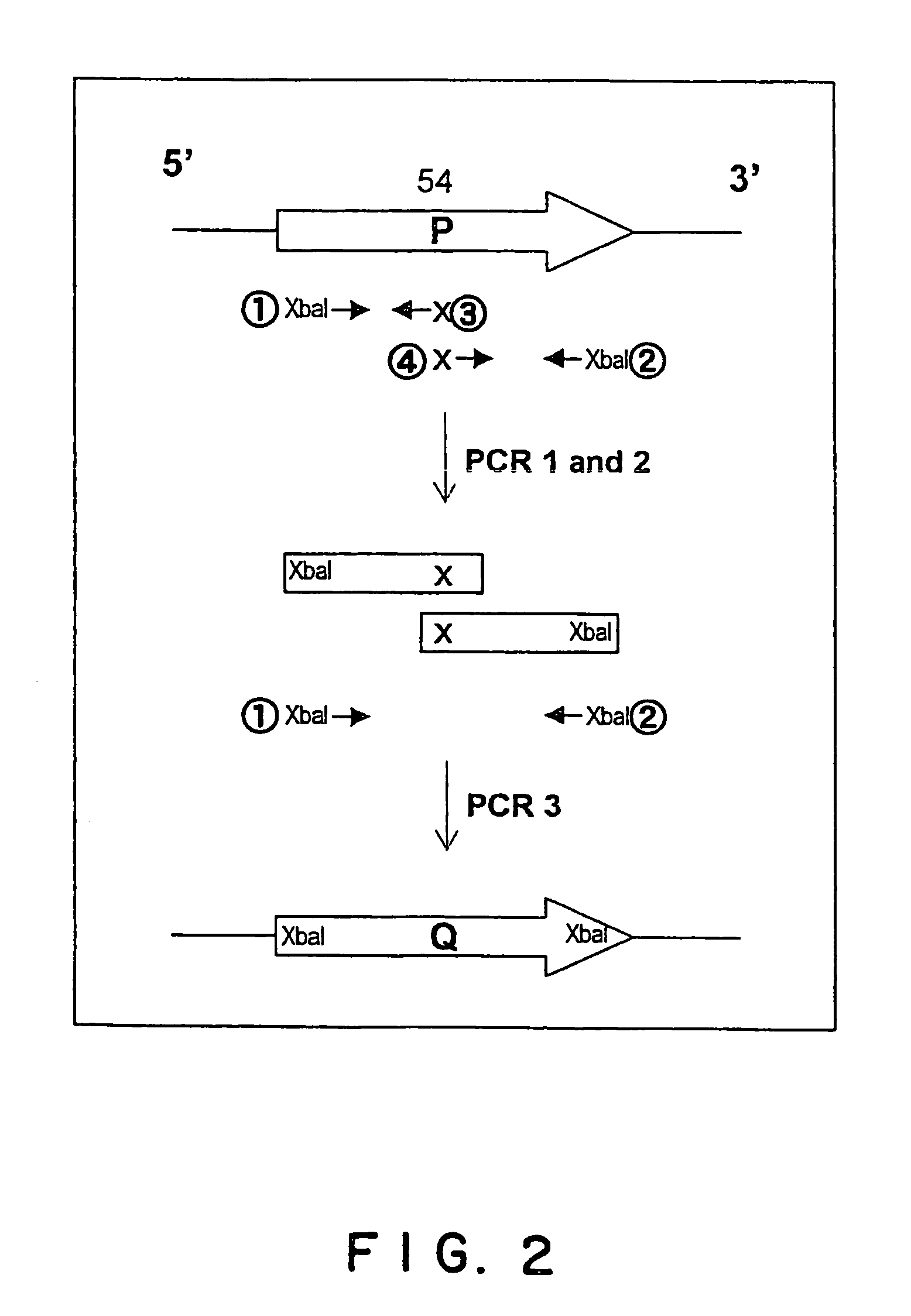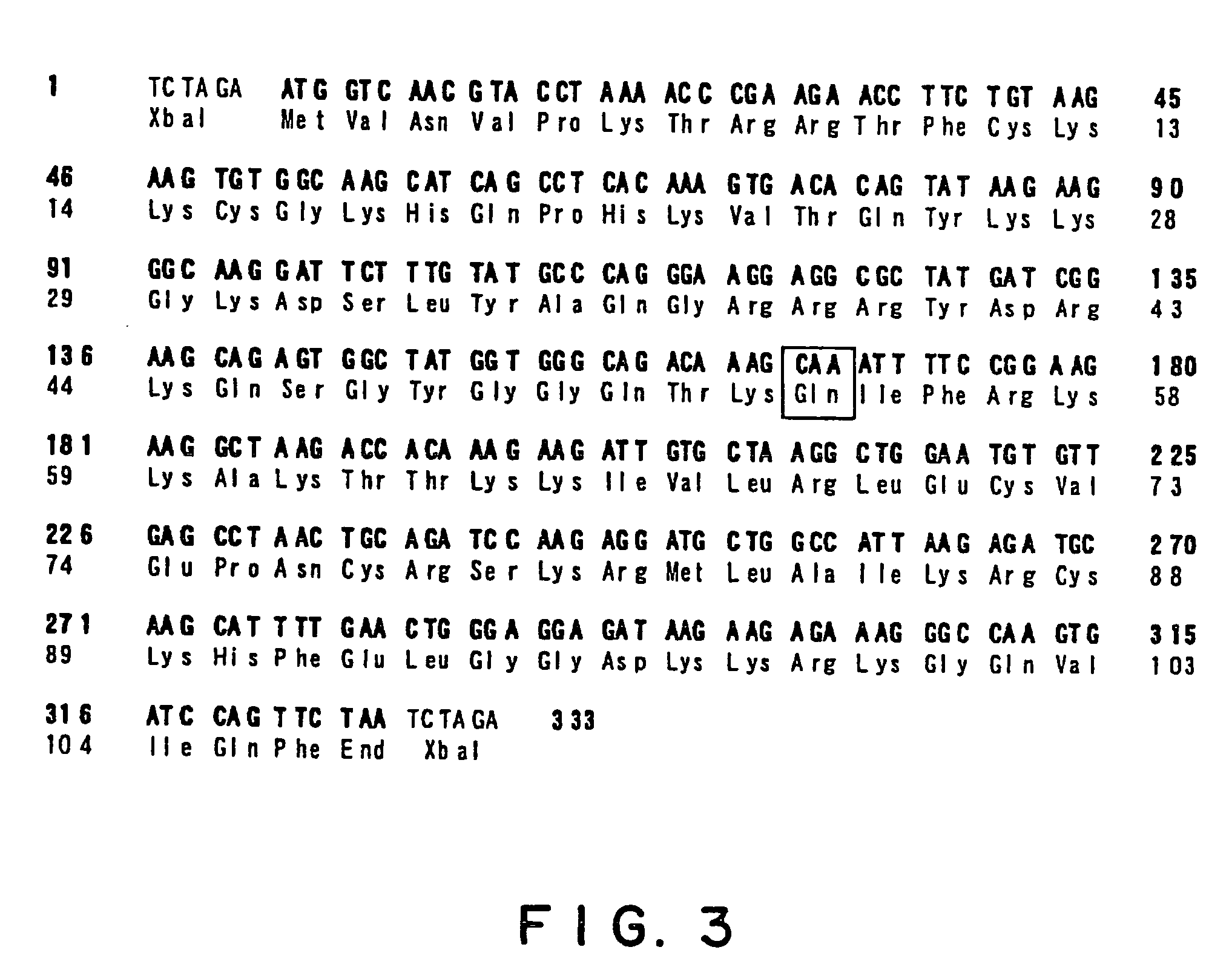Vectors for animal cells and utilization thereof
a technology of vectors and animal cells, applied in the field of recombinant expression vectors, can solve the problems of laborious and time-consuming amplification operation, system-wide protein productivity defect, etc., and achieve the effect of efficient cell selection within a short tim
- Summary
- Abstract
- Description
- Claims
- Application Information
AI Technical Summary
Benefits of technology
Problems solved by technology
Method used
Image
Examples
example 1
Cloning of Human L36a Gene
[0097]It has been confirmed by searching public DNA databases that a human gene homologous to the yeast L41 gene is the L36a gene (GI 4506651). The homology of the amino acid sequences of Candida utilis L41 and L36a is illustrated in FIG. 1. An oligonucleotide HL36G1 (5′-AGA AGT GTG GCA AGC ATC AG-3′, SEQ ID NO: 3) was chemically synthesized and used as a probe. The cDNA of the L36a gene was cloned from the cDNA library (Superscript Human Fetal Brain cDNA Library, Life Technologies, Cat. No. 10662-013) derived from human embryonic brain with Gene Trapper cDNA Positive Selection System (Gibco BRL, Cat. No. 10356-020). Cloning was performed according to the attached manual. Specifically, the double-stranded DNA library in which cDNA has been inserted into the NotI-SalI site of a vector pCMV-SPORT for the expression of animal cells was denatured to be the single-stranded structure, and a hybrid was formed with HL36G1 having a biotin label. The hybrid thus form...
example 2
Construction of Cycloheximide Resistant Gene and Confirmation of its Function
[0098]In order to confer the resistance to CYH on the human L36a gene, mutation in which the amino acid proline at the position 54 is substituted by glutamine was introduced. Specifically, in order to convert the base C at the position 167 of ORF into A, 3 steps of PCR was performed with four chemically synthesized primers as illustrated in FIG. 2. Specifically, PCR was first performed with a combination of the forward primer 1 (5′-GGG TCT AGA ATG GTC AAC GTA CCT AAA AC-3′, SEQ ID NO: 5) and reverse primer 3 (5′-CCG GAA AAT TTG CTT TGT CTG CCC A-3′, SEQ ID NO: 6) and a combination of the forward primer 4 (5′-GGG CAG ACA AAG CAA ATT TTC CGG-3′, SEQ ID NO: 7) and the reverse primer 2 (5′-GGG TCT AGA TTA GAA CTG GAT CAC TTG GC-31, SEQ ID NO: 8) in the presence of the L36a gene as a template. PCR was carried out with Ex Taq polymerase (Takara Shuzo Co., Ltd.) under the condition of PCR ((30 seconds at 94° C., 1...
example 3
Construction of Expression Plasmid
[0100]Three reporter genes were respectively transferred into the BamHI site of pCI-neo-L36 in an opposite direction to the neo gene to construct the expression vectors containing L36a-CYHR. As the reporter gene, a green fluorescent protein having short half life d2EGFP (pd2EGFP-N1 derived, Clontech, 6009-1) and a β-galactosidase (b-galactosidase; lacZ) gene (pCH110 derived, Pharmacia, 27-4508-01), both of which are the reporters accumulated intracellularly and an alkaline phosphatase secreted extracellularly SEAP (pSEAP2-control derived, Clontech, 6052-1) were used.
[0101]The structures of the expression vectors in which each of the three reporter genes has been transferred are illustrated in FIG. 5, and referred to as pL36a-neo-GFP, pL36a-neo-lacZ, pL36a-neo-SEAP, respectively. The vectors pNeo-SEAP and pNeo-lacZ having the same structure as pL36a-neo-lacZ and pL36a-neo-SEAP, respectively, except that L36a-CYHR is not contained were also constructe...
PUM
| Property | Measurement | Unit |
|---|---|---|
| diameter | aaaaa | aaaaa |
| concentration | aaaaa | aaaaa |
| concentration | aaaaa | aaaaa |
Abstract
Description
Claims
Application Information
 Login to View More
Login to View More - R&D
- Intellectual Property
- Life Sciences
- Materials
- Tech Scout
- Unparalleled Data Quality
- Higher Quality Content
- 60% Fewer Hallucinations
Browse by: Latest US Patents, China's latest patents, Technical Efficacy Thesaurus, Application Domain, Technology Topic, Popular Technical Reports.
© 2025 PatSnap. All rights reserved.Legal|Privacy policy|Modern Slavery Act Transparency Statement|Sitemap|About US| Contact US: help@patsnap.com



